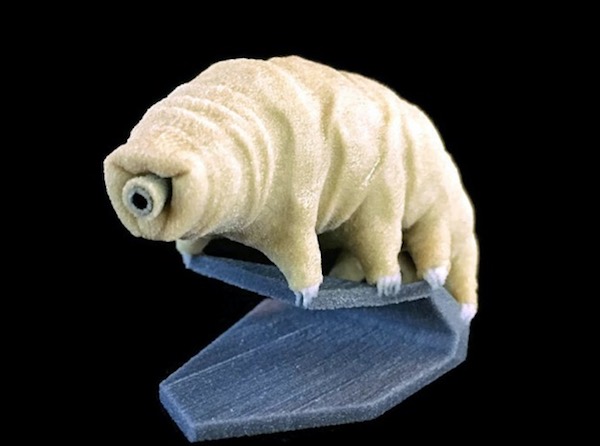
[Image above] A 3-D printed tardigrade. Credit: Eric Ho; Raw Legend Collaborations
When it comes to a ceramic, vitrification makes it impermeable to water.
When it comes to a tardigrade, vitrification makes it impermeable to death.
Tardigrades—a.k.a. water bears—are aquatic micro-animals that can survive nearly any environmental conditions, including desiccation.
Complete lack of water would kill most other creatures, but the tardigrade has a nifty materials trick up one of its eight stubby little arms. These indestructible organisms can coat themselves in glass to survive in a state of suspended animation sans water.
It’s not news that living organisms can make their own biological forms of glass. But unlike sea sponges, which can extract silica out of seawater to produce their glass houses, how does the tardigrade go glassy?
New research reveals that these ancient creatures encode a tardigrade-specific set of proteins that allow the animals’ insides to undergo vitrification, preventing cellular damage that would otherwise occur when proteins and other cell stuff crystallize as water molecules disappear.
By studying what genes tardigrades express when they desiccate, the researchers identified a family of novel proteins called tardigrade-specific intrinsically disordered proteins (TDPs) that replace water molecules within the tardigrade’s drying cells.
TDPs are a type of intrinsically disordered protein, a class of proteins that are unusual because they don’t maintain a well-defined 3-D shape (like most other proteins), instead maintaining a more amorphous structure.
The team of researchers—from the University of North Carolina at Chapel Hill; North Carolina State University (Raleigh, N.C.); University of California, Berkeley; and University of Modena and Reggio Emilia (Italy)—show that tardigrades produce a lot of TDPs when the animals dry out. The amorphous proteins fill up the cytoplasm to vitrify the tardigrades’ drying cells, preventing the cellular destruction that would otherwise occur.
“All the desiccation-sensitive stuff (proteins, nucleic acids, membranes) in the tardigrade cells get trapped in the pores of this matrix, essentially encapsulated in a protective glass-like coating,” lead author Thomas Boothby says in an ARS Techinca article about the research. “This encapsulation prevents the unfolding, rupture, breakage, and/or aggregation of desiccation-sensitive biological material. Once water is added back to the system, the disordered proteins that make up this glassy matrix melt back into solution, leaving behind all the protected parts of the cell.”
Talk about being saved by glass.
But it’s not just tardigrades that can benefit from TDP-mediated vitrification. The researchers also show that expressing TDPs in bacteria and yeast can increase their desiccation tolerance, too—so the finding also has potential applications for prolonging survival of other organisms and products.
For instance, the authors suggest potential applications engineering plants to be more drought-resistant and formulating pharmaceuticals for longer shelf-lives.
Some pharmaceuticals, particularly vaccines, don’t have long shelf lives and even require refrigeration to remain stable enough to be useful, which increases the cost because of high shipping and storage costs. Making vaccines and other pharmaceuticals more stable through vitrification could significantly decrease costs and even extend reach to less developed areas of the world.
Who knew that tiny tardigrades might be so helpful?
The paper, published in Molecular Cell, is “Tardigrades use intrinsically disordered proteins to survive desiccation” (DOI: 10.1016/j.molcel.2017.02.018).
